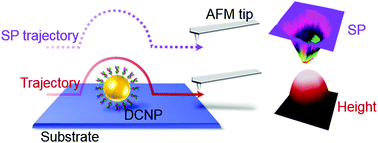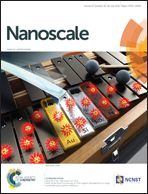Kelvin probe force microscopy of DNA-capped nanoparticles for single-nucleotide polymorphism detection†
Abstract
Kelvin probe force microscopy (KPFM) is a robust toolkit for profiling the surface potential (SP) of biomolecular interactions between DNAs and/or proteins at the single molecule level. However, it has often suffered from background noise and low throughput due to instrumental or environmental constraints, which is regarded as limiting KPFM applications for detection of minute changes in the molecular structures such as single-nucleotide polymorphism (SNP). Here, we show KPFM imaging of DNA-capped nanoparticles (DCNP) that enables SNP detection of the BRCA1 gene owing to sterically well-adjusted DNA–DNA interactions that take place within the confined spaces of DCNP. The average SP values of DCNP interacting with BRCA1 SNP were found to be lower than the DCNP reacting with normal (non-mutant) BRCA1 gene. We also demonstrate that SP characteristics of DCNP with different substrates (e.g., Au, Si, SiO2, and Fe) provide us with a chance to attenuate or augment the SP signal of DCNP without additional enhancement of instrumentation capabilities.


 Please wait while we load your content...
Please wait while we load your content...